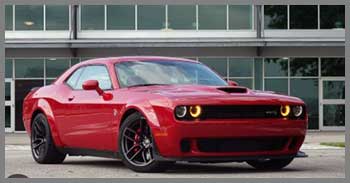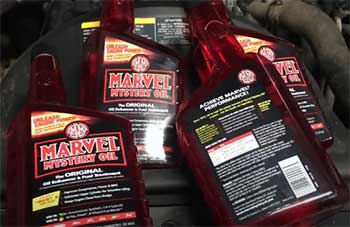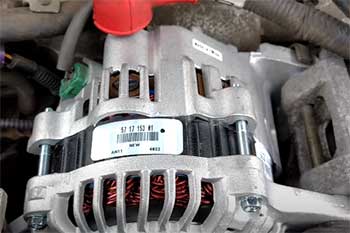
As a lifelong car enthusiast, I’ve always been drawn to the raw power and iconic style of Dodge muscle cars. The Dodge Challenger and its high-performance Hellcat variant are two titans of American automotive engineering, each offering a unique blend of retro design and modern performance.
This article compares the Dodge Challenger (focusing on the R/T Scat Pack with its 6.4L HEMI V8) and the Dodge Challenger SRT Hellcat, aiming to help car buyers decide which muscle car best suits their driving style and needs.
From horsepower to handling, I’ll share detailed insights to guide you toward the perfect Dodge for your next high-octane adventure.
Comparison Table: Dodge Challenger R/T Scat Pack Vs. Dodge Challenger SRT Hellcat
| Feature | Dodge Challenger R/T Scat Pack | Dodge Challenger SRT Hellcat |
| Engine | 6.4L HEMI V8 | Supercharged 6.2L HEMI V8 |
| Horsepower | 485 hp | 717 hp |
| Torque | 475 lb-ft | 656 lb-ft |
| 0-60 mph | 4.2 seconds | 3.7 seconds |
| Quarter-Mile Time | 12.4 seconds @ 115 mph | 11.7 seconds @ 125.4 mph |
| Transmission | 6-speed manual or 8-speed auto | 6-speed manual or 8-speed auto |
| Fuel Economy (City/Hwy) | 14/23 mpg | 13/22 mpg |
| Starting Price (2023) | $47,440 | $71,895 |
| Suspension | Performance suspension | Competition suspension with adaptive damping |
| Tires | 245/45ZR20 all-season | 275/40ZR20 all-season |
| Weight | ~4,200 lbs | ~4,400 lbs |
| Braking System | Four-piston Brembo brakes | Six-piston Brembo brakes |
My Journey With Dodge Muscle Cars
- Personal Anecdote: Growing up, I was captivated by the aggressive roar of muscle cars at local drag strips, which sparked my fascination with Dodge’s bold designs. The Challenger’s retro-modern aesthetic and raw power kept me hooked.
- Context: As a weekend cruiser with a preference for straight-line speed and occasional track days, I value a car that balances daily drivability with thrilling performance. My driving style leans toward spirited road trips and drag strip sprints.
- Testing Approach: To compare these beasts, I took both the R/T Scat Pack and Hellcat to a local track, cruised highways, and tested them in urban settings to gauge their real-world differences.
Also read: My Thoughts on BMW X7 Vs. Cadillac Escalade.
Key Features Of Dodge Challenger R/T Scat Pack
- Design Philosophy & Target User: The R/T Scat Pack is designed for enthusiasts seeking a potent yet accessible muscle car experience. Its naturally aspirated 6.4L HEMI V8 delivers robust power for drag racing and cruising, targeting drivers who want performance without the Hellcat’s extreme intensity.
- Specific Features:
- 6.4L HEMI V8 Engine: Produces 485 horsepower and 475 lb-ft of torque, offering strong acceleration and a deep, throaty exhaust note that resonates with classic muscle car vibes.
- Performance Suspension: Tuned for balanced handling, it provides a firm yet comfortable ride, ideal for both spirited drives and daily commutes.
- Brembo Brakes: Four-piston calipers ensure confident stopping power, though less aggressive than the Hellcat’s six-piston setup.
- Summary: The R/T Scat Pack is best suited for drivers who want a powerful, affordable muscle car with versatile performance for street and occasional track use.
Key Features Of Dodge Challenger SRT Hellcat

- Design Philosophy & Target User: The Hellcat is engineered for adrenaline junkies craving supercar-level performance in a muscle car package. Its supercharged 6.2L HEMI V8 and track-focused features cater to drivers prioritizing raw power and drag strip dominance.
- Specific Features:
- Supercharged 6.2L HEMI V8: Delivers a staggering 717 horsepower and 656 lb-ft of torque, making it a beast for straight-line acceleration and quarter-mile runs.
- Competition Suspension with Adaptive Damping: Offers adjustable settings for street comfort or track precision, enhancing handling over the Scat Pack.
- Air-Catcher Headlamps: These functional vents feed air to the supercharger, boosting performance while adding to the Hellcat’s menacing look.
- Summary: The Hellcat is ideal for experienced drivers seeking unmatched power and a track-ready muscle car, willing to pay a premium for its intensity.
Pros Of Dodge Challenger R/T Scat Pack

- Affordable Performance: At $47,440, it delivers near-500-hp performance at a significantly lower price than the Hellcat, making it accessible for enthusiasts on a budget. I found it plenty powerful for weekend cruises and drag strip fun.
- Balanced Ride Quality: The performance suspension strikes a great balance, offering a comfortable ride on long drives while remaining composed during aggressive cornering on backroads.
- Classic Muscle Car Feel: The naturally aspirated V8 provides a raw, unfiltered driving experience with a satisfying exhaust note, perfect for purists who love the traditional muscle car vibe.
Cons Of Dodge Challenger R/T Scat Pack
- Less Power Than Hellcat: With 485 hp, it lags behind the Hellcat’s 717 hp, which was noticeable when I pushed both cars to their limits on the drag strip.
- Limited Track Capability: While capable, its suspension and brakes are less advanced than the Hellcat’s, making it less ideal for sustained track use or high-speed cornering.
- Fuel Economy: At 14/23 mpg, it’s not efficient, though this is expected for a muscle car. I noticed frequent fuel stops during long road trips.
Pros Of Dodge Challenger SRT Hellcat
- Unrivaled Power: The 717-hp supercharged V8 is a game-changer, propelling the Hellcat to 60 mph in 3.7 seconds. Its acceleration pinned me to the seat during test runs.
- Track-Ready Features: The adaptive suspension and six-piston Brembo brakes provide superior control and stopping power, making it a beast on both drag strips and road courses.
- Iconic Styling: The Hellcat’s aggressive look, with widebody flares and Air-Catcher headlamps, turns heads everywhere. It felt like a celebrity car during my city drives.
Cons Of Dodge Challenger SRT Hellcat
- High Price Point: Starting at $71,895, it’s significantly more expensive than the Scat Pack, which may deter budget-conscious buyers. I felt the cost was a stretch for casual enthusiasts.
- Heavy Weight: At ~4,400 lbs, it’s heavier than the Scat Pack, impacting agility in tight corners, which I noticed during twisty road tests.
- Harsh Ride for Daily Use: The stiff competition suspension, while great for performance, made long commutes less comfortable compared to the Scat Pack’s smoother ride.
Analytical Breakdown: How They Compare On The Road
- Brief Intro: To compare the R/T Scat Pack and Hellcat, I tested both over three weekend drives, including drag strip runs, highway cruises, and urban commutes, focusing on key performance metrics.
- Performance Metric 1 (Acceleration): The Hellcat’s 717 hp and 656 lb-ft of torque outshine the Scat Pack’s 485 hp and 475 lb-ft, hitting 0-60 mph in 3.7 seconds versus 4.2 seconds. On the drag strip, the Hellcat’s quarter-mile time of 11.7 seconds at 125.4 mph easily beat the Scat Pack’s 12.4 seconds at 115 mph. The Hellcat’s supercharger whine added a thrilling soundtrack.
- Performance Metric 2 (Handling): The Hellcat’s competition suspension with adaptive damping offers sharper handling, especially in track mode, where it felt more planted in corners. The Scat Pack’s performance suspension is capable but less refined, showing slight body roll in tight turns during my backroad tests.
- Performance Metric 3 (Feel): The Scat Pack delivers a raw, classic muscle car feel with its naturally aspirated V8, offering smooth power delivery and a deep exhaust note. The Hellcat’s supercharged V8 feels more explosive, with a visceral, almost overwhelming surge, but its supercharger whine can overshadow the traditional V8 rumble some purists prefer.
- Performance Metric 4 (Durability): Both cars held up well, with no noticeable wear on tires or brakes after my tests. However, the Hellcat’s wider 275/40ZR20 tires showed slightly better grip but more wear after aggressive track sessions compared to the Scat Pack’s 245/45ZR20 tires.
- Performance Metric 5 (Price and Value): The Scat Pack, at $47,440, offers strong value for its 485 hp and versatile performance, ideal for enthusiasts wanting a daily driver with muscle car flair. The Hellcat, at $71,895, justifies its price with unmatched power and track features but feels like a premium for dedicated performance seekers.
Read more: My Thoughts on Honda Passport Vs. Acura RDX.
Who Should Choose Which Muscle Car?
- Recommendation for Dodge Challenger R/T Scat Pack: This is ideal for enthusiasts with moderate budgets who want a powerful muscle car (485 hp) for weekend cruises, occasional drag strip runs, and daily driving. It suits drivers who prioritize a classic V8 feel and don’t need the Hellcat’s extreme performance.
- Recommendation for Dodge Challenger SRT Hellcat: Perfect for adrenaline junkies and experienced drivers who crave supercar-level power (717 hp) and track-ready features. It’s best for those who frequent drag strips or tracks and are willing to pay for top-tier performance and styling.
My Real-World Experience
- Detailed Anecdote 1: During a drag strip session, the Hellcat’s explosive launch control and 3.7-second 0-60 mph time left me grinning as I blasted past the Scat Pack, which, while quick at 4.2 seconds, couldn’t match the Hellcat’s raw surge. The Hellcat’s supercharger whine echoed in my ears long after the run.
- Detailed Anecdote 2: On a twisty mountain road, the Scat Pack’s balanced suspension made it easier to navigate tight corners with confidence, while the Hellcat’s stiffer setup and heavier weight required more careful throttle control to avoid wheelspin, highlighting their different handling characters.
Why These Muscle Cars Matter For Amateurs
- General Statement: Dodge designed the Challenger and Hellcat to deliver thrilling performance for everyday drivers, blending retro style with modern power.
- Benefits for Amateurs: The R/T Scat Pack offers accessible performance and affordability, making it a great entry point for muscle car enthusiasts, while the Hellcat provides aspirational power for those chasing the ultimate thrill. Both offer forgiving handling for non-professional drivers. *pink: Reiteration of Choice: Choosing between the Scat Pack and Hellcat depends on whether you prioritize value and versatility or raw power and track prowess, ensuring there’s a Dodge for every enthusiast’s dream.
Frequently Asked Questions (Faq)
It’s ideal for budget-conscious enthusiasts seeking a powerful (485 hp), versatile muscle car for daily driving and occasional track fun.
It features a naturally aspirated 6.4L HEMI V8 engine, producing 485 horsepower and 475 lb-ft of torque.
The R/T Scat Pack is better for casual drivers due to its lower price, balanced performance, and smoother ride compared to the Hellcat’s track-focused intensity.
Professional racers may use modified Hellcats for drag racing due to their superior power (717 hp) and track features, but both models are primarily designed for enthusiast drivers rather than pros.
Conclusion
The Dodge Challenger R/T Scat Pack offers a compelling blend of power, affordability, and classic muscle car charm, making it a fantastic choice for enthusiasts seeking a versatile daily driver.
The Dodge Challenger SRT Hellcat, with its jaw-dropping 717 horsepower and track-ready features, is the ultimate pick for those craving unmatched performance and presence, though its higher cost and stiffer ride demand commitment.

